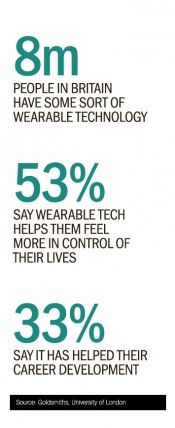Right now much of the hype around wearable technology focuses on consumer devices – think Apple Watch, Google Glass, and devices from Pebble, Jawbone and Fitbit. But many industry watchers believe it will be businesses and not consumers that will drive the wearables trend.
Among them is J.P. Gownder, an analyst at IT market research firm Forrester Research. “The market for company-provided wearables will be larger than the consumer market in the next five years,” he predicts. Wearables, he says, “have the potential to change the way organisations and workers conduct business.”
Another believer is Duncan Stewart, a research director at management consultancy Deloitte. “The rationale for enterprise use of wearables makes a great deal of sense,” he says. “There are a huge number of jobs where people need to be able to work hands-free, but receive information at the same time. These jobs provide pressing business-use cases for enterprise wearables, with tremendous return on investment potential.”
Take, for example, a busy warehouse. “You’ve got workers driving forklift trucks with two hands, attempting to navigate their way around aisles of shelving, often poorly signposted,” says Mr Stewart. “Meanwhile, the specific item they’ve been asked to retrieve may be in the wrong place, or it may be in the right place, but three aisles up, four rows over and behind two other objects.”
Here, he says, a head-mounted, augmented reality display, showing the worker where the item is and the best route to reach it, could slash retrieval times and boost productivity.
At online food retailer Ocado, chief technology officer Paul Clarke is keeping a close eye on the wearables trend. The company operates two main customer fulfilment centres, in Hatfield, Hertfordshire and Dordon, Warwickshire, 15 regional “spokes” nationwide and a fleet of more than 800 delivery vans. There’s “massive” potential, he says, to use wearable technologies to provide warehouse staff and drivers with a constant stream of hands-free, up-to-the-minute information relating to the specific task or delivery they’re working on. So much so, in fact, that behind the scenes, Ocado IT staff are already working on speculative development projects for Google Glass and other wearables.
“And it’s not just the watches and the headsets – that’s just scratching the surface,” he says. “There’s also smart apparel and fabrics, too, for example. We could do all sorts of things with this technology.”
HEALTHCARE POTENTIAL
Healthcare is another area where there is plenty of scope for wearable technologies to take off. Already there’s great excitement in the sector around early deployments of connected devices that are implanted into, attached to or worn by patients to monitor cardiac conditions, blood pressure levels and sleep patterns, for example.
There are a huge number of jobs where people need to be able to work hands-free, but receive information at the same time
But medical staff could be equipped with wearable technologies, too. A headset worn by a surgeon, for instance, could update them with information on a patient’s vital signs during surgery, as well as capture footage of the operation for use as a teaching tool for students. Any device with a camera, in fact, could allow medical staff to scan barcodes or smart tags to identify patients, bring up their medical record and check the right medications, in the right doses, are being administered.
The potential applications are almost limitless – smart jackets for firefighters that sense the presence of toxic gases or flammable chemicals, smart watches for manufacturing-plant workers that alert them when stocks of a particular component need replenishing, smart headsets for retail workers that let them know, in a non-intrusive, customer-friendly way, that a clean-up is needed in aisle three.
Motorola Solutions, meanwhile, offers seven different wearables for public safety officials, such as police officers. These include a biometric monitoring device that can identify when an officer is in distress or injured and a wearable sensor that alerts armed officers when their guns are unlocked.
However, there are currently substantial barriers to adoption. For Mr Clarke at Ocado, these include the cost of wearable devices, their limited battery life and the substantial challenge of integrating new devices with existing back-end systems.
But there is still time for both technology vendors and end-user organisations to get their strategies straight, according to Mr Gownder at Forrester Research.
The years between 2014 and 2016, he says, will be for piloting and early adoption. “With vendors still working to bring out offerings, we’ll remain in the nascent stages for the next few years,” he predicts.
Between 2017 and 2019, wearables will start to go mainstream, as developers launch the necessary apps, back-end software and services needed to support enterprise wearables on a broader scale.
But by 2020, wearables will be “commonplace” among employees at many enterprises. There will be devices tailored to particular industries, specific roles, even individual organisations. “For some businesses, wearable tools will become central to how their employees do their jobs,” Mr Gownder concludes. The wearable workplace, it seems, may be just around the corner.

